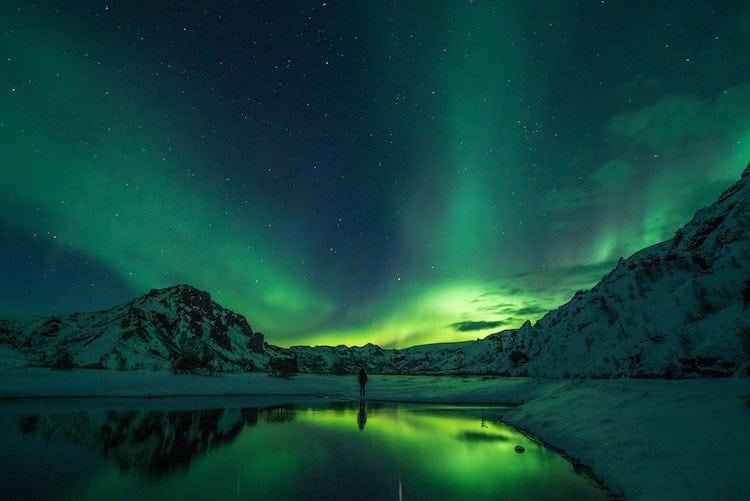What are the northern lights?
If you’ve happened upon this blog, chances are you already know a little about the northern lights. But here’s a quick summary just in case. The Aurora Borealis graces our skies when gas particles from the sun’s surface drift towards gas particles on the earth’s surface – this causes a reaction of colours in the atmosphere – the northern lights. The distance from the surface of the reaction, and the gases colliding determines the colour (pink, red, purple, blue or green).
Why is Iceland a great place to see the northern lights?
The northern lights are visible from any country within the auroral band: Finland, Sweden, Norway, Iceland, Greenland and Canada. While these are all great places to experience the Aurora Borealis, Iceland consistently tops the charts. The northern lights in Iceland are visible for an incredible eight months, but the darkest months are your best bet (October – March). But as wondrous as the northern lights are, they do only come out at night. Use the days to explore one of the world’s best adventure playgrounds! From towering mountains, thundering waterfalls, spurting geysers, natural hot springs, black beaches, diamond beaches and boiling mud pools. Iceland is natural diversity at its best.
Where are the best places to see the northern lights in Iceland?
In general, you should be able to catch the northern lights anywhere without light pollution. To maximise your chances of seeing it, the skies also need to be clear, which generally means the temperature will be significantly lower – wrap up warm! A reliable source for determining when the northern lights can occur is the Aurora Forecast. Here are a few of the best places to see the northern lights in Iceland.
Thingvellir National Park
Thingvellir National Park is one of the best areas to see the Aurora Borealis show. The park is far from any source of artificial light, and the scenery is out of this world. The largest lake in Iceland is also within the park’s boundaries. It provides an incredible backdrop for photos, the growing lights bouncing off the reflection of the lake. Then hike up to the moss-covered lava hills for some extraordinary lookout spots.
Grótta
If you are staying in Reykjavik, Grótta is the nearest, best place to see the northern lights. Situated at the tip of Seltjarnarnes peninsula, it’s only a 10-minute drive from the capital but just far out enough that there is no light pollution. And what can be better than gazing out to sea as you watch the northern lights creep across the sky?
Öskjuhlið Hill
Öskjuhlið hill is one of the best lookouts for witnessing the northern lights. Öskjuhlið is 61 meters above sea level with a dense forest running below. And being just outside of Reykjavik, it’s a great location if you’re staying within the city. On top of the hill is Perlan, a stunning museum with an enormous rotating glass dome, but the best bit is at the top. Three floors up provide incredible all-round views – an excellent place for watching the Aurora Borealis.
Vik
Öskjuhlið hill is one of the best lookouts for witnessing the northern lights. Öskjuhlið is 61 meters above sea level with a dense forest running below. And being just outside of Reykjavik, it’s a great location if you’re staying within the city. On top of the hill is Perlan, a stunning museum with an enormous rotating glass dome, but the best bit is at the top. Three floors up provide incredible all-round views – an excellent place for watching the Aurora Borealis.
Seljavallalaug Pool
A little different to the others is the Seljavallalaug Pool. A natural hot-water spring, nestled amongst the rolling hills in southern Iceland. This secluded spot is perfect for northern lights chasers. Chilling in a natural hot spring far from civilisation, while the Aurora Borealis streaks across the star-studded sky is undoubtedly nothing short of magical.



